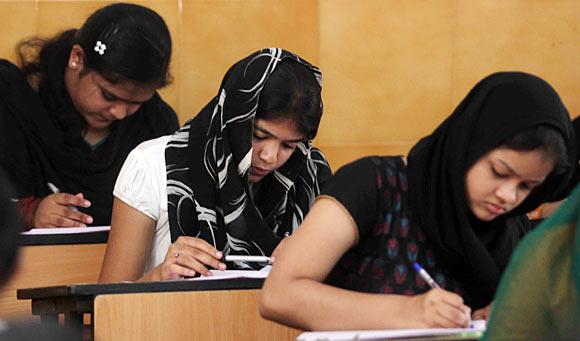Photographs: Courtesy Careers360 Divya Nair
Parents and medical students react to the Supreme Court judgement that quashed the common medical entrance exam populary known as NEET-UG.
Just a few hours after the SC judgement deputy editor of IBN 18, Network (CNN –IBN) Sagarika Ghose tweeted ‘@sagarikaghose: Disclosure:my son took #NEET this year qualified with a good rank. 2 yrs of backbreaking study, but still loopholes. GOI needs to wake up.’
Ghose was among the many parents who were reacting to the Supreme Court verdict that quashed the Medical Council of India’s decision to hold a common national entrance exam for medical, dental and post graduate studies in the country.
The Supreme Court said that the National Eligibility Entrance Examination (NEET-UG) violated Articles 19, 25, 26, 29 and 30 of the Constitution.
The SC was acting on the 115 petitions that had challenged the MCI notification on NEET for admission to the above courses.
Who filed these petitions and what influenced the Supreme Court to arrive at the decision? More importantly, what is the NEET?
'The government is playing with our careers'
Image: The entrance exam was a part of MCI's Vision 2015 towards standardising medical admission in the countryPhotographs: Sahil Salvi/Rediff.com
The story behind NEET
When the National Eligibility Entrance Examination (NEET-UG) was given the go-ahead in 2011 for the academic year 2012-13, the country’s education system was taking a bold step towards MCI’s Vision 2015 that aimed at standardising the eligibility criteria of admission and bringing in uniformity across institutes in the country.
The MCI had felt that having a common entrance exam like the NEET-UG would ‘convenience students’ because it would not help them ‘save time and resources’ but will also take care of certain malpractices like variable capitation fee that existed in the selection procedure.
So, why did it fail?
Although the vision looked good and foolproof on paper, it lacked in its implementation in its first year itself.
The MCI decided to implement the NEET-UG for the academic year 2013-14 instead of 2012-13.
After months of desperation, when the syllabus and paper pattern was finally announced, states like Andhra Pradesh, Karnataka, Gujarat, West Bengal and Tamil Nadu stood their ground and opposed the exam, stating that there was a huge variation in the syllabus proposed by the MCI and that followed by the state.
More than four lakh students were affected by this stand-off between the MCI and the state.
“The common entrance exam was like a dream come true for all of us. However, as days passed, the disagreement between state colleges and the MCI continued to increase, which added to our problems. Even today, there is no clarity about the merit lists or the allotment of seats. The government is playing with our careers,” says Dr Viveka Parthasarathy who is working at a private hospital in Satara district of Maharashtra and is also preparing for her postgraduate entrance exam.
While Maharashtra, Gujarat and Goa had agreed to conduct the NEET from 2013-14, Andhra Pradesh said it would do so only in 2014-15.
'There was no clarity on the syllabus; we did not know what to study'
Image: Students who took the first NEET-UG on May 5, 2013 faced several issuesPhotographs: Sahil Salvi/Rediff.com
After endless debates and interventions, the country’s first NEET-UG exam was held on May 5, 2013, the results for which were announced June 5, 2013.
Sharing his experience of appearing for the first NEET-UG, Dr Suraj Nair who graduated with a medical degree from Lokmanya Tilak Hospital, Mumbai points out some of the problems he faced.
“We had to wait an entire day to register for the exam on October 4 because the server could not handle the traffic. Same was the case when the results were announced. Although the decision was taken, there was no clarity on the syllabus; we did not know what to study until November 23 and when finally the exam happened, the pattern was not what was promised in the vision 2015. Besides, private colleges were exempt from the judgement because of an interim order. There was no change in the number of seats; NEET was more or less similar to the All India Pre Medical Test.”
The ambiguity in the allotment of seats surprised many, who went on to complain how the exam had failed in its very purpose -- that of providing a uniform and fair chance to every deserving medical aspirant.
With private colleges backing out, the number of available seats continued to remain the same.
“NEET was originally aimed at including all medical seats, including those from private colleges as well, which is good and just what the system wants -- more medical seats and transparency. But as the interim verdict came in May 2012, NEET was made optional for state quota. Karnataka was one such state that was given the freedom to conduct their own entrance exam for state quota. Now that state colleges were allowed to organise independent counseling which led to allotment of seats, merit holders could now have access to two seats -- one through all-India quota and the other through the state quota, which is obviously unfair,” adds Dr Nair.
Why the NEET-UG should be brought back
Image: Parents and medical aspirants feel the NEET-UG will bring in transparency of admissionPhotographs: Sahil Salvi/Rediff.com
Despite the loopholes in the system, educationists, students and parents feel that if properly implemented the decision will bring in a lot of transparency and improve the opportunities for deserving students.
Fifty-two-year-old Premalatha Iyer from Mumbai whose younger son Aditya is preparing for a medical career shares her concerns.
“My elder son had studied at a government medical college. The living conditions at most government medical hospitals in our country is poor. Having a common entrance exam will help our children get access to the best government and private medical colleges. If they work so hard and get a place in the merit list, they deserve to get the best colleges to study. For every 1000 seats, lakhs of students appear for the exam. To improve their chances, these students have to appear for multiple state-level exams that have different syllabus. It is practically impossible for any medical student to prepare and appear for so many entrance exams. My only appeal to the government is to find a way to get as many colleges under the purview of the NEET and get it implemented at the earliest.”





Comment
article